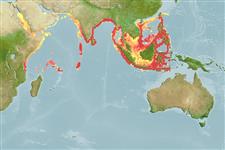Environment: milieu / climate zone / depth range / distribution range
Écologie
marin; eau douce; saumâtre démersal; amphidrome (Ref. 51243); profondeur 10 - 961 m (Ref. 9494). Tropical; 25°N - 10°S, 32°E - 127°E
Indo-West Pacific: Malay Archipelago including Thailand, Viet Nam, the Philippines and Indonesia westward to seas and estuaries of India and Pakistan to the Red Sea (Ref. 9895).
Length at first maturity / Taille / Poids / Âge
Maturity: Lm 10.8, range 9 - 12.2 cm
Max length : 45.0 cm TL mâle / non sexé; (Ref. 11298); common length : 25.0 cm TL mâle / non sexé; (Ref. 9895)
Épines dorsales (Total): 0; Rayons mous dorsaux (Total): 126-138; Épines anales 0; Rayons mous anaux: 97 - 114; Vertèbres: 57 - 66.
Adults live mainly in shallow muddy and sandy bottoms of the continental shelf, sometimes entering estuaries and tidal rivers (Ref. 1479, 48637). Usually deeply buried in the substrate during the day, but out and hunting at night (Ref. 48637). They feed mainly on benthic invertebrates. Marketed mostly fresh and frozen; also dried-salted (Ref. 9895).
Menon, A.G.K., 1977. A systematic monograph of the tongue soles of the genus Cynoglossus Hamilton-Buchanan (Pisces: Cynoglossidae). Smithson. Contrib. Zool. (238):1-129. (Ref. 5297)
Statut dans la liste rouge de l'IUCN (Ref. 130435)
Menace pour l'homme
Harmless
Utilisations par l'homme
Pêcheries: commercial
Outils
Articles particuliers
Télécharger en XML
Sources Internet
Estimates based on models
Preferred temperature (Ref.
123201): 8.8 - 18.2, mean 12.3 °C (based on 243 cells).
Phylogenetic diversity index (Ref.
82804): PD
50 = 0.5000 [Uniqueness, from 0.5 = low to 2.0 = high].
Bayesian length-weight: a=0.01514 (0.00592 - 0.03870), b=3.00 (2.77 - 3.23), in cm total length, based on LWR estimates for this (Sub)family-body shape (Ref.
93245).
Niveau trophique (Ref.
69278): 3.5 ±0.37 se; based on food items.
Résilience (Ref.
120179): Milieu, temps minimum de doublement de population : 1,4 à 4,4 années (Fec = 360-35,926).
Fishing Vulnerability (Ref.
59153): Low to moderate vulnerability (35 of 100).
Nutrients (Ref.
124155): Calcium = 115 [50, 215] mg/100g; Iron = 0.899 [0.453, 1.673] mg/100g; Protein = 18.2 [15.8, 20.4] %; Omega3 = 0.176 [0.088, 0.368] g/100g; Selenium = 99 [44, 213] μg/100g; VitaminA = 11 [3, 40] μg/100g; Zinc = 0.977 [0.649, 1.475] mg/100g (wet weight);
